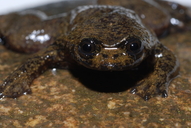|
Barbourula kalimantanensis Iskandar, 1978
Kalimantan Jungle Toad, Bornean Flat-headed Frog | family: Bombinatoridae genus: Barbourula |
 © 2008 David Bickford (1 of 9)
|
|
|
|
Description Barbourula kalimantanensis is the only known lungless frog (Bickford et al. 2008). This species is a medium-sized frog (males to 66 mm SVL, females to 77.7 mm SVL), characterized by a distinct broad, extremely flattened, depressed head, rounded snout, and a stocky, depressed body (Iskandar 1978; Iskandar 1995). The nostrils of this frog are located at the end of the snout and are flush with the skin. There is no canthus rostralis and no lores. Eyes are located anterolaterally on the head, with a free nasolacrimal papilla positioned just below the lower eyelid. The tympanic annulus is lacking. Both the maxilla and premaxilla of B. kalimantanensis are toothed, with two partitioned rows behind the choanae. Vomerine teeth of this frog species resemble a pair of tubercles and are situated on the roof of the mouth just posterior to the choanae. The tongue is circular (Iskandar 1978; Iskandar 1995). No glottis (protected opening to the airway) is present, unlike any other known frog species, and the esophageal opening leads directly to the stomach (Bickford et al. 2008). Males lack vocal sacs (Iskandar 1978; Iskandar 1995). The arms and legs are stout, with fully webbed hands and feet. The hands and feet are unusual in that they resemble paddles, with the second and third fingers being roughly equal and the third and fourth toes also. Fingertips of B. kalimantanensis are distinctively enlarged into discs, but lack a circummarginal groove. Three low metacarpal tubercles are present on the hand, but the hand lacks any subarticular tubercles. Toe discs are enlarged as a series, with the first toe disc being the largest. A thick ridge of skin is present along the median edge of the first toe. The foot of B. kalimantanensis has an inner metatarsal tubercle but lacks an outer metatarsal tubercle. There is a fold of skin along the rear of the thigh as well as one along the tibia. Female B. kalimantanensis are distinguishable by the appearance of triangular muscle projections on either side of their cloaca, known as anal claspers. Dorsally, the skin texture of B. kalimantanensis is rugose (wrinkly and creased), with small projecting tubercles or spinules located on the posterior portion of the dorsum and on the hindlimbs. Ventrally, the skin is smooth (Iskandar 1978; Iskandar 1995). Specimens preserved in alcohol are uniformly black in dorsal coloration; the ventral coloration is dark with indistinct lighter marbling (brown mottling in the single preserved male specimen and yellow mottling in the single preserved female specimen) (Iskandar 1978; Iskandar 1995). The color in life is brown with black mottling. Distribution and Habitat Country distribution from AmphibiaWeb's database: Indonesia
Barboroula kalimantanensis occurs in the Kapuas River Basin, West Kalimantan, and in central Kalimantan, Indonesia (Borneo). This species is primarily aquatic and is found in clear, cold (14-17 degrees C), swift (2-5 m/sec), shallow freshwater rivers, 20-50 m wide, within primary rainforest (Iskandar 1978; Iskandar 1995; Bickford et al. 2008). Life History, Abundance, Activity, and Special Behaviors This species is the only known frog species to lack lungs. It is primarily aquatic, preferring clear fresh water streams at depths of 0.5 to 5 m, with moderate to strong currents. The hands and feet are paddle-like, facilitating swimming. It shelters under large rocks within the streams (Iskandar 1978; Iskandar 1995). The extreme flattening of the body likely serves to increase surface area for oxygen exchange, since this species respires entirely through the skin (Bickford et al. 2008). Only two specimens were caught within a 20 year span. A single specimen was first collected in 1978 within the Pinoh River, a small sea level tributary off the Kapuas River, in west Kalimantan, Indonesia (Iskandar 1978). The second specimen was collected near the type locality, in 1995 (Iskandar 1995). Subsequently two new populations were reported from central Kalimantan, upstream from the original type locality which no longer contains suitable habitat (Bickford et al. 2008). Trends and Threats Barboroula kalimantanensis is classified as endangered (IUCN 2006). This species is completely aquatic and requires cool, clear rivers as habitat. The main threat to B. kalimantanensis consists of habitat loss caused by illegal logging and gold mining. These activities result in increased stream turbidity from siltation and pollution from mercury contamination. Deforestation can also increase stream temperature due to lack of cover. Respiration is via the skin since B. kalimantanensis lacks lungs entirely, and thus this aquatic species requires water with a high oxygen content. Warm, sluggish, turbid waters have lower levels of oxygen than cool, clear, fast-flowing rivers ((Bickford et al. 2008). Possible reasons for amphibian decline Habitat modification from deforestation, or logging related activities Comments
References
Bickford, D., Iskandar, D., and Barlian, A. (2008). ''A lungless frog discovered on Borneo.'' Current Biology, 18, R374-R375. Iskandar, D. T. (1978). ''A new species of Barbourula: first record of a discoglossid anuran in Borneo.'' Copeia, 1978, 564-566. Iskandar, D. T. (1995). ''Note on the second specimen of Barbourula kalimantanensis.'' The Raffles Bulletin Of Zoology, 43(2), 309-311. Originally submitted by: Adam Boisvert (first posted 2007-10-23) Edited by: Kellie Whittaker (2014-10-29) Species Account Citation: AmphibiaWeb 2014 Barbourula kalimantanensis: Kalimantan Jungle Toad <https://amphibiaweb.org/species/2039> University of California, Berkeley, CA, USA. Accessed Mar 30, 2025.
Feedback or comments about this page.
Citation: AmphibiaWeb. 2025. <https://amphibiaweb.org> University of California, Berkeley, CA, USA. Accessed 30 Mar 2025. AmphibiaWeb's policy on data use. |




 Map of Life
Map of Life